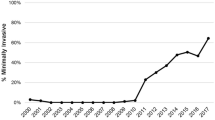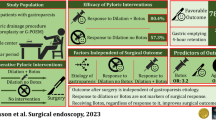Abstract
Background
Many centers use botulinum toxin for chemical pyloroplasty in minimally invasive esophagectomies as prophylaxis against delayed gastric emptying. No previous studies have compared botulinum toxin injection with no pyloric intervention for patients treated with a combined laparoscopic and thoracoscopic approach. The authors hypothesized that chemical pyloroplasty does not improve outcomes for these patients.
Methods
The study investigated patients undergoing minimally invasive esophagectomies from September 2009 to June 2015. Delayed gastric emptying was defined as inability to tolerate a soft diet by postoperative day 10, as corroborated by esophagram, upper endoscopy, or both. Data were compared using Student’s t test, χ 2 analysis, and Mann–Whitney U test where appropriate.
Results
The study identified 71 patients treated with minimally invasive esophagectomy: 35 patients with chemical pyloroplasty treated from September 2009 to January 2014 and 36 patients without pyloric intervention from February 2014 to June 2015. The groups were statistically similar in age, gender distribution, T stage, percentage of patients receiving neoadjuvant therapy, body mass index, preoperative weight loss, preoperative serum albumin, and preoperative placement of feeding tubes (all p > 0.05). The overall incidence of delayed gastric emptying was low in both groups: 8.6% (3/35) of the patients with chemical pyloroplasty versus 5.6% (2/36) of the patients with no pyloric intervention (p = 0.62). The two groups also did not differ significantly in the development of aspiration pneumonia or the need for pyloric intervention.
Conclusions
In a well-matched cohort study with a historical control group, use of botulinum toxin for chemical pyloroplasty in minimally invasive esophagectomies was not associated with improved outcomes related to the pylorus versus no pyloric intervention. Although preliminary, these data suggest that chemical pyloroplasty is not necessary in minimally invasive esophagectomy.
Similar content being viewed by others
References
Nason KS. Minimal or maximal surgery for esophageal cancer? J Thorac Cardiovasc Surg. 2016;151:633–5.
Luketich JD, Pennathur A, Awais O, et al. Outcomes after minimally invasive esophagectomy: review of over 1000 patients. Ann Surg. 2012;256:95–103.
Biere SS, van Berge Henegouwen MI, Maas KW, et al. Minimally invasive versus open oesophagectomy for patients with oesophageal cancer: a multicentre, open-label, randomised controlled trial. Lancet. 2012;379:1887–92.
Eldaif SM, Lee R, Adams KN, et al. Intrapyloric botulinum injection increases postoperative esophagectomy complications. Ann Thorac Surg. 2014;97:1959–65.
Martin JT, Federico JA, McKelvey AA, Kent MS, Fabian T. Prevention of delayed gastric emptying after esophagectomy: a single center’s experience with botulinum toxin. Ann Thorac Surg. 2009;87:1708–14.
Arya S, Markar SR, Karthikesalingam A, Hanna GB. The impact of pyloric drainage on clinical outcome following esophagectomy: a systematic review. Dis Esophagus. 2015;28:326–35.
Palmes D, Weilinghoff M, Colombo-Benkmann M, Senninger N, Bruewer M. Effect of pyloric drainage procedures on gastric passage and bile reflux after esophagectomy with gastric conduit reconstruction. Langenbecks Arch Surg. 2007;392:135–41.
Antonoff MB, Puri V, Meyers BF, et al. Comparison of pyloric intervention strategies at the time of esophagectomy: is more better? Ann Thorac Surg. 2014;97:1950–8.
Gaur P, Swanson SJ. Should we continue to drain the pylorus in patients undergoing an esophagectomy? Dis Esophagus. 2014;27:568–73.
Mehran R, Rice D, El-Zein R, et al. Minimally invasive esophagectomy versus open esophagectomy, a symptom assessment study. Dis Esophagus. 2011;24:147–52.
Chattopadhyay TK, Gupta S, Padhy AK, Kapoor VK. Is pyloroplasty necessary following intrathoracic transposition of stomach? Results of a prospective clinical study. Aust N Z J Surg. 1991;61:366–9.
Cheung HC, Siu KF, Wong J. Is pyloroplasty necessary in esophageal replacement by stomach? A prospective, randomized controlled trial. Surgery. 1987;102:19–24.
Fok M, Cheng SW, Wong J. Pyloroplasty versus no drainage in gastric replacement of the esophagus. Am J Surg. 1991;162:447–52.
Ben-David K, Sarosi GA, Cendan JC, Howard D, Rossidis G, Hochwald SN. Decreasing morbidity and mortality in 100 consecutive minimally invasive esophagectomies. Surg Endosc. 2012;26:162–7.
Nguyen NT, Dholakia C, Nguyen XM, Reavis K. Outcomes of minimally invasive esophagectomy without pyloroplasty: analysis of 109 cases. Am Surg. 2010;76:1135–8.
Cerfolio RJ, Bryant AS, Canon CL, Dhawan R, Eloubeidi MA. Is botulinum toxin injection of the pylorus during Ivor Lewis esophagogastrectomy the optimal drainage strategy? J Thorac Cardiovasc Surg. 2009;137:565–72.
Nigam PK, Nigam A. Botulinum toxin. Indian J Dermatol. 2010;55:8–14.
Huang W, Foster JA, Rogachefsky AS. Pharmacology of botulinum toxin. J Am Acad Dermatol. 2000;43:249–59.
Borodic GE, Ferrante R, Pearce LB, Smith K. Histologic assessment of dose-related diffusion and muscle fiber response after therapeutic botulinum A toxin injections. Mov Disord. 1994;9:31–9.
Author Contributions
C.S.—study design, data collection, data analysis, data interpretation, drafting of manuscript; L.W.—study design, data collection; A.H.—study design, data collection; C.B.—study design, data collection; M.B.—study design, data collection; A.G.—data analysis, data interpretation, critical manuscript revisions; J.D.M.—study design, data interpretation, critical manuscript revisions; M.J.W.—study design, data interpretation, critical manuscript revisions; R.M.—study design, data interpretation, critical manuscript revisions; C.G.—study design, data interpretation, critical manuscript revisions; B.H.E.—study design, data interpretation, critical manuscript revisions; M.M.—study design, data interpretation, drafting of manuscript, critical manuscript revisions.
Conflict of interest
There are no conflict of interest.
Author information
Authors and Affiliations
Corresponding author
Rights and permissions
About this article
Cite this article
Stewart, C.L., Wilson, L., Hamm, A. et al. Is Chemical Pyloroplasty Necessary for Minimally Invasive Esophagectomy?. Ann Surg Oncol 24, 1414–1418 (2017). https://doi.org/10.1245/s10434-016-5742-x
Received:
Published:
Issue Date:
DOI: https://doi.org/10.1245/s10434-016-5742-x




